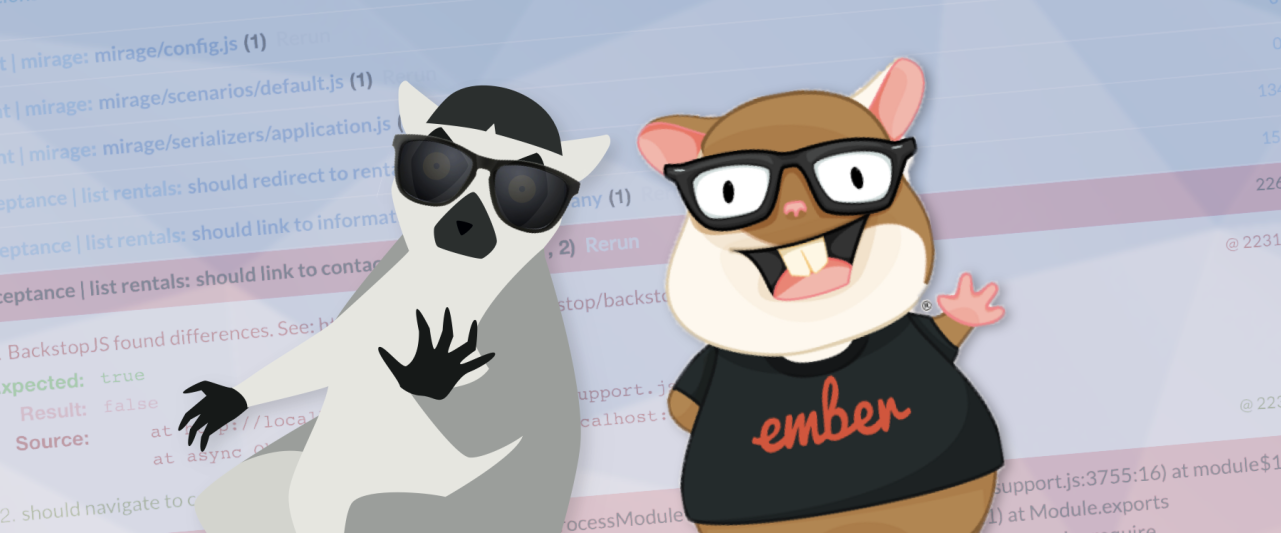Awesome
ember-backstop

BackstopJS visual regression testing addon for Ember.
- Simple to add, Simple to use.
- Works in Local or CI pipeline.
- Manages your test and reference files.
- Works in your existing Acceptance and Integration tests.
TLDR;
QUICK TUTORIAL 👉 If you are new and just want a quick tutorial, try this step-by-step -- you'll be automatically diffing screenshots in about 5 mins! https://github.com/garris/ember-backstop-tutorial/
Installation
First do this...
ember install ember-backstop
Next, for Git...
Add these lines to your <project>/gitignore...
#backstopjs
html_report
bitmaps_test
If you use Mirage
Add this line to <project>/mirage/config.json...
this.passthrough('/backstop/**');
If you use Pretender
Add a passthrough in your pretender config file:
Something like this:
this.post('/backstop/**', this.passthrough);
If you test with ember test
Add this to your <project>/testem.js...
proxies: {
'/backstop': {
target: 'http://localhost:3000',
secure: false,
},
},
Usage
Backstop-remote service
You will need the backstop-remote service running for visual tests.
In a separate window run...
ember backstop-remote
Leave that running while you're testing. When you don't need it anymore you can either close the window or run ember backstop-stop to stop the service.
Running Ember Server
Ember-Backstop works with ember test and ember serve e.g.
ember test --server --filter="your_test_name_partial"
or
ember serve
Adding a visual regression test is simple...
First import the backstop helper into your test...
import backstop from 'ember-backstop/test-support/backstop';
Then add an await backstop(assert); assertion to any UI state you want to test...
test('it renders the thing', async function(assert) {
await visit('/sales/company/11102');
await backstop(assert);
assert.dom('#myFancyElement').exists();
});
Now, whenever you run a test, BackstopJS will take a screen shot and compare it against the last known good.
The first run
The first time you run backstop-helper tests BackstopJS will fail because there aren't any reference files yet. So, here's what you do...
- run tests normally
- When tests complete, in another window run
ember backstop-approve
Your next test run should now pass.
View the most recent BackstopJS test report
You can always view the last test run report by running the following in another window...
ember backstop-report
Approving changes
Anytime you want to promote a changed test to the new reference file, run...
ember backstop-approve
This command also takes an optional filter parameter e.g.
ember backstop-approve --filter=testFilenameAsRegExString
Configuration Options
The backstop helper takes an optional options object.
Scenario Option
You can configure BackstopJS scenario options for your tests dynamically by passing a scenario object in the options.
test('it renders the thing - selects the .jumbo selector - and compares with a custom mismatch threshold', async function(assert) {
await visit('/sales/company/11102');
await backstop(assert, { scenario: { selectors: '.jumbo', misMatchThreshold: 0.05 } });
assert.dom('#myFancyElement').exists();
});
See Scenario Documentation for what you can configure.
Name Option
You can add a custom name segment to your backstop test artifacts by passing a name property in the options.
test('shows specific rental details', async function(assert) {
await visit('/rentals');
await click('.grand-old-mansion');
await backstop(assert);
await backstop(assert, { name: 'WITH A CUSTOM NAME' });
});
The above produces two identical backstop tests with the following titles...
1) Acceptance__list_rentals__shows_specific_rental_details__assert0_0_document_0_webview
2) Acceptance__list_rentals__shows_specific_rental_details__WITH_A_CUSTOM_NAME__assert1_0_document_0_webview
Using the Kill Switch
Taking screenshots is a heavy process and there may be conditions where you want to run Ember tests but skip all the backstop tests. For these occations there is a kill switch called disableBackstop. Setting this to true will "skip" all backstop helper calls. You can configure this in enviornment.js. See below...
/* environment.js */
module.exports = function(environment) {
let ENV = {
/* ... other existing configs ABOVE this line */
'ember-backstop': {
disableBackstop: process.env.DISABLE_BACKSTOP === 'true'
}
/* ... other existing configs BELOW this line */
};
return ENV;
};
With the above in place, setting the environment variable DISABLE_BACKSTOP=true will engage the kill switch.
e.g.
DISABLE_BACKSTOP=true ember s
DISABLE_BACKSTOP=true ember test
DISABLE_BACKSTOP=true ember exam
Reference-Only mode
Sometimes you just want to generate reference screenshots -- without actually testing anything. You can tell ember-backstop to do this by setting screenshotsOnly to true in enviornment.js...
/* environment.js */
module.exports = function(environment) {
let ENV = {
/* ... other existing configs ABOVE this line */
'ember-backstop': {
screenshotsOnly: true
}
/* ... other existing configs BELOW this line */
};
return ENV;
};
More Info
See http://backstopjs.org for documentation on BackstopJS -- but keep in mind -- for this implementation all DOM interactions should probably be done in your Ember test -- and not the BackstopJS config.
Issues
If your screenshots are blank
Take a look at your test network calls. Are you seeing UnrecognizedURLError errors? If so, there may be an issue with a middleware addon dependency loading too early. Try ensuring any server dependencies don't block proxy requests to /backstop/. Post the issue here and let us know!
Questions/comments?
Post an issue, propose a feature or just say Hi! https://github.com/garris/ember-backstop/issues
Contributing
Yes. Please pitch in to make this addon awesome for everyone.
Compatibility
- Ember.js v2.18 or above
- Ember CLI v2.13 or above
- Node.js v8 or above
License
This project is licensed under the MIT License.
Ember, the Ember logo design and the Tomster designs are exclusive trademarks registered in the United States by Tilde Inc.. Used here with permission.